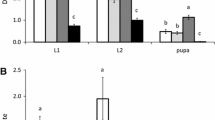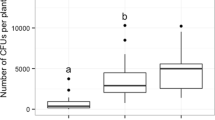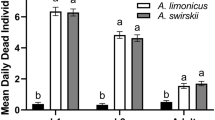Abstract
Predatory mites of the family Phytoseiidae feed on herbivorous mites and insects but they also use a variety of non-prey food items, such as pollen and nectar. Plant tissue is another potential food source. We investigated whether plant feeding occurs in the two phytoseiids Euseius scutalis (Athias-Henriot) and Typhlodromips swirskii (Athias-Henriot), which are natural enemies of whiteflies. These predatory mites can suppress populations of Bemisia tabaci (Gennadius) on isolated plants and are candidates for biological control of this pest. Both species can be reared on a diet of pollen, but E. scutalis requires a leaf tissue substrate, suggesting that this species might feed on plant tissue. To test this hypothesis, we applied a systemic insecticide (aldicarb) to cucumber plants and assessed the survival of predatory mites on leaves from insecticide-treated plants and untreated plants, both in presence and absence of pollen. The survival of T. swirskii was not affected by the presence of systemic insecticide in the plant. However, the survival of E. scutalis on leaves from insecticide-treated plants was 10 times lower than on leaves from untreated plants. Since the two species showed similar sensitivity to the insecticide when applied in a slide-dip test, this suggests that E. scutalis ingested insecticide through feeding on the leaf tissue. Mortality on treated leaves was observed both in absence and presence of pollen, suggesting that plant feeding is indispensable for E. scutalis. The extent to which plants are used as food by E. scutalis requires further analysis.
Similar content being viewed by others
References
Alomar O. and Wiedenmann R.N. (eds) 1996. Zoophytophagous Heteroptera: Implications for Life History and Integrated Pest Management. Thomas Say Publications, Entomological Society of America, Lanham, MD, 202 pp.
Bakker F.M. 1993. Selecting phytoseiid predators for biological control, with emphasis on the significance of tri-trophic interactions. Ph.D. Thesis, University of Amsterdam.
Barret D. 1995. Influence de l'architecture du phylloplan dans l'organisation des peuplements de phytoséiides (Acari) et dans leurs associations avec les plantes. Ph.D. Thesis, École Nationale Supe´rieure Agronomique de Montpellier.
Busvine J.R. 1971. A Critical Review of the Techniques for Testing Insecticides. Commonwealth Agricultural Bureaux, London, 345 p.
Chant D.A. 1959. Phytoseiid mites (Acarina: Phytoseiidae). Part I. Bionomics of seven species in southeastern England. Can. Entomol. 91: 5–44.
Coll M. 1998. Living and feeding on plants in predatory Heteroptera. In: Coll M. and Ruberson J.R. (eds) Predatory Heteroptera: Their Ecology and Use in Biological Control. Thomas Say Publications, Entomological Society of America, Lanham, MD, pp. 89–130.
Coll M. and Guershon M. 2002. Omnivory in terrestrial arthropods: mixing plant and prey diets. Ann. Rev. Entomol. 47: 267–297.
Eichhorn K.W. and Hoos D. 1990. Investigations in population dynamics of Typhlodromus pyri in vineyards of Palatina, F.R. Germany. In: Schmid A. (ed) Intergrated Control in Viticulture. IOBC/WPRS Bulletin XIII/(7): 120–123.
Gabarra R., Castañe C. and Albajes R. 1995. The mirid bug Dicyphus tamaninii as a greenhouse whitefly and western flower thrips predator on cucumber. Biocontrol Sci. Technol. 5: 475–488.
Grafton-Cardwell E.E. and Ouyang Y. 1996. Influence of citrus leaf nutrition on survivorship, sex ratio, and reproduction of Euseius tularensis (Acari: Phytoseiidae). Environm. Entomol. 25: 1020–1025.
Grevstad F.S. and Klepetka B.W. 1992. The influence of plant architecture on the foraging efficiencies of a suite of ladybird beetles feeding on aphids. Oecologia 92: 399–404.
Hosmer D.W. and Lemeshow S. 1999. Applied Survival Analysis. Regression Modeling of Time to Event Data. Wiley, New York, 386 p.
Janssen A., Pallini A., Venzon M. and Sabelis M.W. 1999. Absence of odour-mediated avoidance of heterospecific competitors by the predatory mite Phytoseiulus persimilis. Entomol. Exp. Appl. 92: 73–82.
Krips O.E., Kleijn P.W., Willems P.E.L., Gols G.J.Z. and Dicke M. 1999. Leaf hairs influence searching efficiency and predation rate of the predatory mite Phytoseiulus persimilis (Acari: Phytoseiidae). Exp. Appl. Acarol. 23: 119–131.
Magalháes S. and Bakker F.M. 2002. Plant feeding by a predatory mite inhabiting cassava. Exp. Appl. Acarol. 27: 27–37.
Marquis R.J. and Whelan C. 1996. Plant morphology, and recruitment of the third trophic level: Subtle and little-recognized defenses? Oikos 75: 330–334.
Naranjo S.E. and Gibson R.L. 1996. Phytophagy in predaceous Heteroptera: effects on life history and population dynamics. In: Alomar O. and Wiedenmann R.N. (eds) Zoophytophagous Heteroptera: Implications for Life History and Integrated Pest Management. Thomas Say Publications, Entomological Society of America, Lanham, MD, pp. 57–93.
Nomikou M., Janssen A., Schraag R. and Sabelis M.W. 2001. Phytoseiid predators as potential biological control agents for Bemisia tabaci. Exp. Appl. Acarol. 25: 270–290.
Nomikou M., Janssen A., Schraag R. and Sabelis M.W. 2002. Phytoseiid predators suppress populations of Bemisia tabaci on cucumber plants with alternative food. Exp. Appl. Acarol. 27: 57–68.
Nomikou M., Janssen A. and Sabelis M.W. 2003. Phytoseiid predators of whiteflies feed and reproduce on non-prey food sources. Exp. Appl. Acarol. (this issue).
Overmeer W.P.J. 1985. Rearing and handling. In: Spider Mites, Their Biology, Natural Enemies and Control. Vol. 1b. Helle W. and Sabelis M.W. (eds) Elsevier, Amsterdam, pp. 162–170.
Penman D.R. and Chapman R.B. 1988. Pesticide-induced mite outbreaks: pyrethroids and spider mites. Exp. Appl. Acarol. 4: 265–276.
Porres M.A., McMurtry J.A. and March R.B. 1975. Investigations of leaf sap feeding by three species of phytoseiid mites by labeling with radioactive phosphoric acid (H3 32 PO4). Ann. Entomol. Soc. Am. 68: 871–872.
Ragusa S. and Swirski E. 1977. Feeding habits, post-embrionic and adult survival, mating, virility and fecundity of the predacious mite Amblyseius swirskii (Acarina: Phytoseiidae) on some coccids and mealybugs. Entomophaga 22: 381–392.
Ridgway R.L. and Jones S.L. 1968. Plant feeding by Geocoris pallens and Nabis americoferus. Ann. Entomol. Soc. Am. 61: 232–233.
Sabelis M.W. 1990. How to analyse prey preference when prey density varies? A new method to discriminate between effects of gut fullness and prey type composition. Oecologia 82: 289–298.
Sokal R.R. and Rohlf F.J. 1995. Biometry (3rd edn). Freeman, New York.
Swirski E., Amitai S. and Dorzia N. 1967. Laboratory studies on the feeding, development and reproduction of the predaceous mites Amblyseius rubini Swirski and Amitai and Amblyseius swirskii Athias (Acarina: Phytoseiidae) on various kind of food substances. Israel J. Agric. Res. 17: 101–119.
Teich Y. 1966. Mites of the family of Phytoseiidae as predators of the tobacco whitefly, Bemisia tabaci (Gennadius). Israel J. Agric. Res. 16: 141–142.
van Haren R.J.F., van Steenhuis M.M., Sabelis M.W. and de Ponti O.M.B. 1987. Tomato stem trichomes and dispersal success of Phytoseiulus persimilis relative to its prey Tetranychus urticae. Exp. Appl. Acarol. 3: 115–121.
van Houten Y.M., van Rijn C.J., Tanigoshi L.K., van Stratum P. and Bruin J. 1995. Preselection of predatory mites to improve year-round biological control of western flower thrips in greenhouse crops. Ent. Exp. Appl. 74: 225–234.
van Rijn P.C.J. and Tanigoshi L.K. 1999a. Pollen as food for the predatory mites Iphiseius degenerans and Neoseiulus cucumeris (Acari: Phytoseiidae): dietary range and life history. Exp. Appl. Acarol. 23: 785–802.
van Rijn P.C.J. and Tanigoshi L.K. 1999b. The contribution of extrafloral nectar to survival and reproduction of the predatory mite Iphiseius degenerans on Ricinus communis. Exp. Appl. Acarol. 23: 281–296.
Walter D.E. 1996. Living on leaves: mites, tomenta, and leaf domatia. Ann. Rev. Entomol. 41: 101–114.
Zaher M.A. and Shehata K.K. 1971. Biological studies on the predatory mite Typhlodromus pyri Sch. (Acarina: Phytoseiidae) with effect of prey and nonprey substances. Z. Angew. Entomol. 64: 389–94.
Zemek R. and Prenerová E. 1997. Powdery mildew (Ascomycotina: Erysiphales)-an alternative food for the predatory mite Typhlodromus pyri Scheuten (Acari: Phytoseiidae). Exp. Appl. Acarol. 21: 405–414.
Author information
Authors and Affiliations
Corresponding author
Rights and permissions
About this article
Cite this article
Nomikou, M., Janssen, A. & Sabelis, M.W. Phytoseiid predator of whitefly feeds on plant tissue. Exp Appl Acarol 31, 27–36 (2003). https://doi.org/10.1023/B:APPA.0000005150.33813.04
Issue Date:
DOI: https://doi.org/10.1023/B:APPA.0000005150.33813.04




